Strategic Management Report: Regis Healthcare Aged Care Analysis
VerifiedAdded on 2022/08/25
|10
|2241
|17
Report
AI Summary
This report presents a strategic analysis of Regis Healthcare Corporation, focusing on its Residential Aged Care Division. The analysis begins with an overview of the organization's background, including its market scope, services, and financial performance within the Australian aged care industry. A macro-environment analysis is then conducted, utilizing both SWOT and PESTLE frameworks to assess the company's strengths, weaknesses, opportunities, threats, and the impact of political, economic, social, technological, legal, and environmental factors. Furthermore, the report employs Porter's Five Forces model to evaluate the competitive landscape, examining factors such as the threat of new entrants, bargaining power of suppliers and buyers, threat of substitutes, and the intensity of rivalry among existing competitors. The analysis concludes with a summary of the company's strategic position and recommendations for future development and growth within the competitive aged care sector.
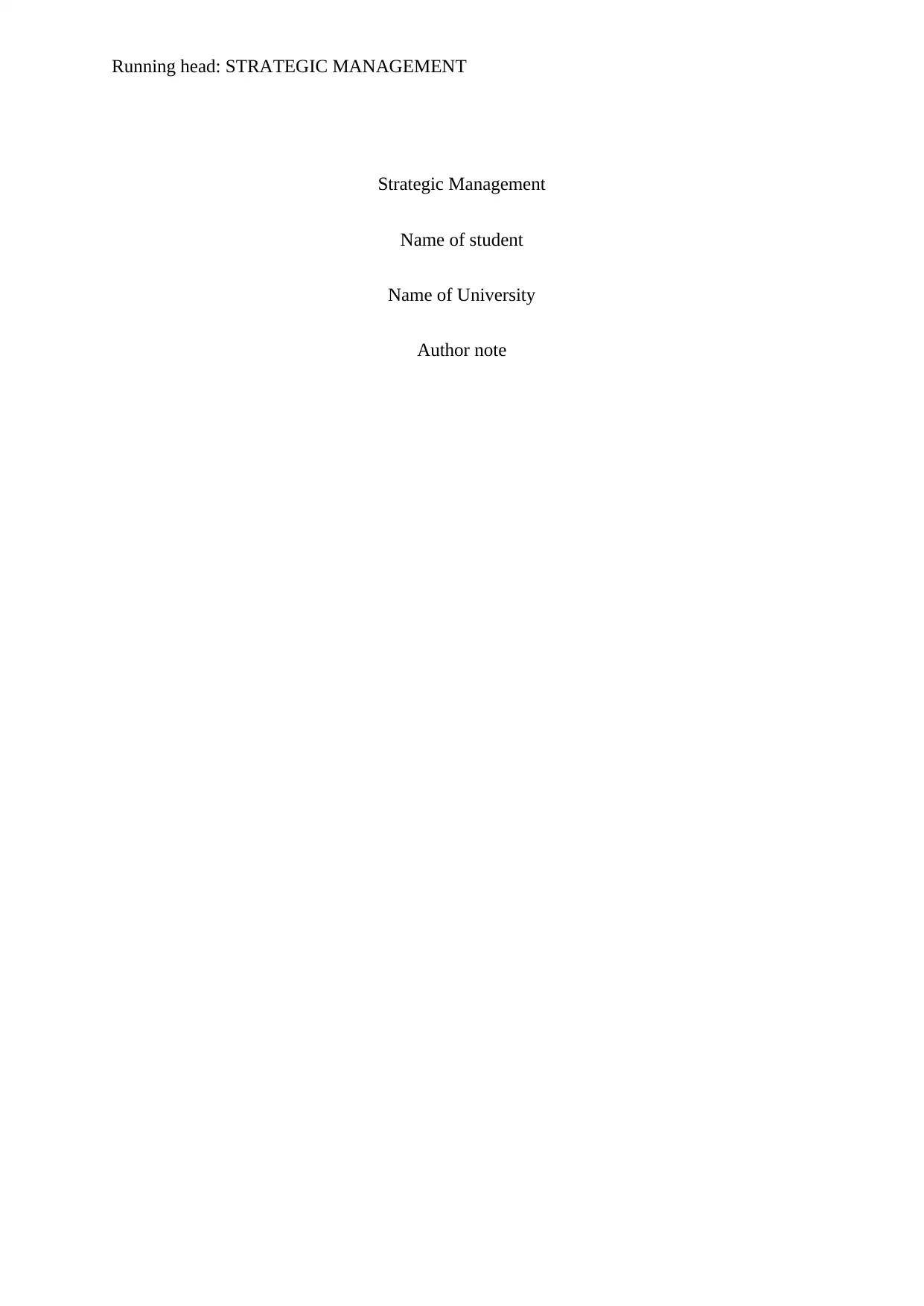
Running head: STRATEGIC MANAGEMENT
Strategic Management
Name of student
Name of University
Author note
Strategic Management
Name of student
Name of University
Author note
Paraphrase This Document
Need a fresh take? Get an instant paraphrase of this document with our AI Paraphraser
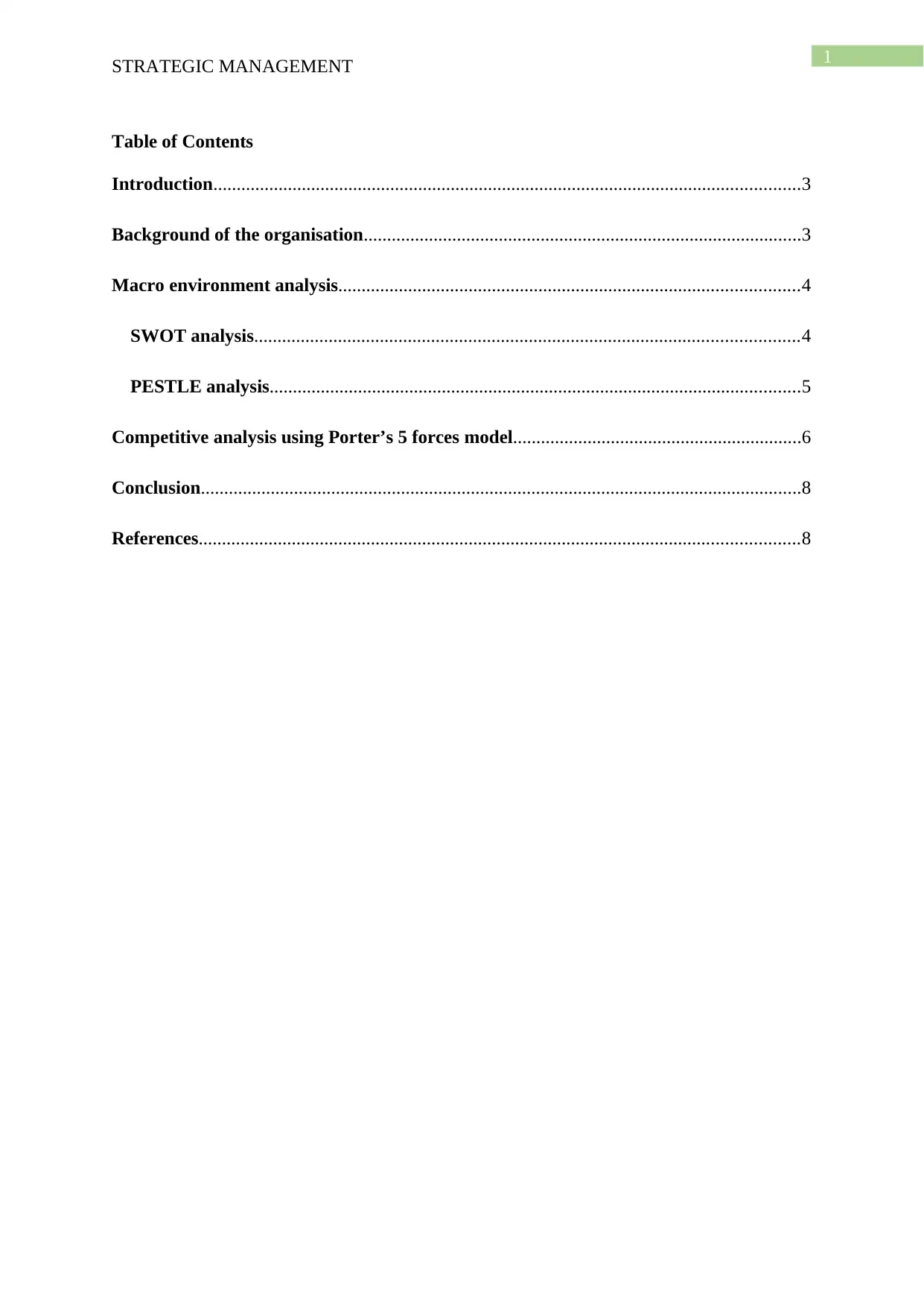
1
STRATEGIC MANAGEMENT
Table of Contents
Introduction..............................................................................................................................3
Background of the organisation..............................................................................................3
Macro environment analysis...................................................................................................4
SWOT analysis.....................................................................................................................4
PESTLE analysis..................................................................................................................5
Competitive analysis using Porter’s 5 forces model..............................................................6
Conclusion.................................................................................................................................8
References.................................................................................................................................8
STRATEGIC MANAGEMENT
Table of Contents
Introduction..............................................................................................................................3
Background of the organisation..............................................................................................3
Macro environment analysis...................................................................................................4
SWOT analysis.....................................................................................................................4
PESTLE analysis..................................................................................................................5
Competitive analysis using Porter’s 5 forces model..............................................................6
Conclusion.................................................................................................................................8
References.................................................................................................................................8

2
STRATEGIC MANAGEMENT
Introduction
The report is prepared to discuss about the conducting of strategic analysis of the
Regis Healthcare Corporation for Residential Aged Care Division, which has been a major
public listed organisation in Australia, aiming to deliver good quality care services to people
for meeting their health needs and preferences. The task will present an idea about the
strategic context of the organisation and its relevance with various aspects including the
market size, business scope, products and services along with major markets being targeted
and financial performance too (Ansoff et al. 2018). It will also include a macro environment
analysis by using the SWOT analysis framework and PESTLE analysis framework along
with analyse the competition situation by using the Porter’s five forces model (Regis.com.au
2020).
Background of the organisation
Regis Healthcare Corporation in Australia is a major organisation aimed at providing
aged care faculties all over Australia, allow for the older people to stay at retirement villages,
provide home care along with both health and social care services for meeting the needs and
requirements of the older people or individuals with disabilities who need support to carry out
various activities (Rothaermel 2016). The company aims at managing provision of residential
aged care services as well as include the market segments including the New South Wales,
Queensland and Victoria to which, the services are to be delivered to. The numbers of
employees working at the organisation are over 8000 and it has been managed through
Government funding, which ranges about 416.33million AUD and resident fees of more than
168.81 million AUD. The CEO of the company is Linda Mellors and the chairman is Graham
Kennedy Hodges (Regis.com.au 2020).
STRATEGIC MANAGEMENT
Introduction
The report is prepared to discuss about the conducting of strategic analysis of the
Regis Healthcare Corporation for Residential Aged Care Division, which has been a major
public listed organisation in Australia, aiming to deliver good quality care services to people
for meeting their health needs and preferences. The task will present an idea about the
strategic context of the organisation and its relevance with various aspects including the
market size, business scope, products and services along with major markets being targeted
and financial performance too (Ansoff et al. 2018). It will also include a macro environment
analysis by using the SWOT analysis framework and PESTLE analysis framework along
with analyse the competition situation by using the Porter’s five forces model (Regis.com.au
2020).
Background of the organisation
Regis Healthcare Corporation in Australia is a major organisation aimed at providing
aged care faculties all over Australia, allow for the older people to stay at retirement villages,
provide home care along with both health and social care services for meeting the needs and
requirements of the older people or individuals with disabilities who need support to carry out
various activities (Rothaermel 2016). The company aims at managing provision of residential
aged care services as well as include the market segments including the New South Wales,
Queensland and Victoria to which, the services are to be delivered to. The numbers of
employees working at the organisation are over 8000 and it has been managed through
Government funding, which ranges about 416.33million AUD and resident fees of more than
168.81 million AUD. The CEO of the company is Linda Mellors and the chairman is Graham
Kennedy Hodges (Regis.com.au 2020).
⊘ This is a preview!⊘
Do you want full access?
Subscribe today to unlock all pages.

Trusted by 1+ million students worldwide
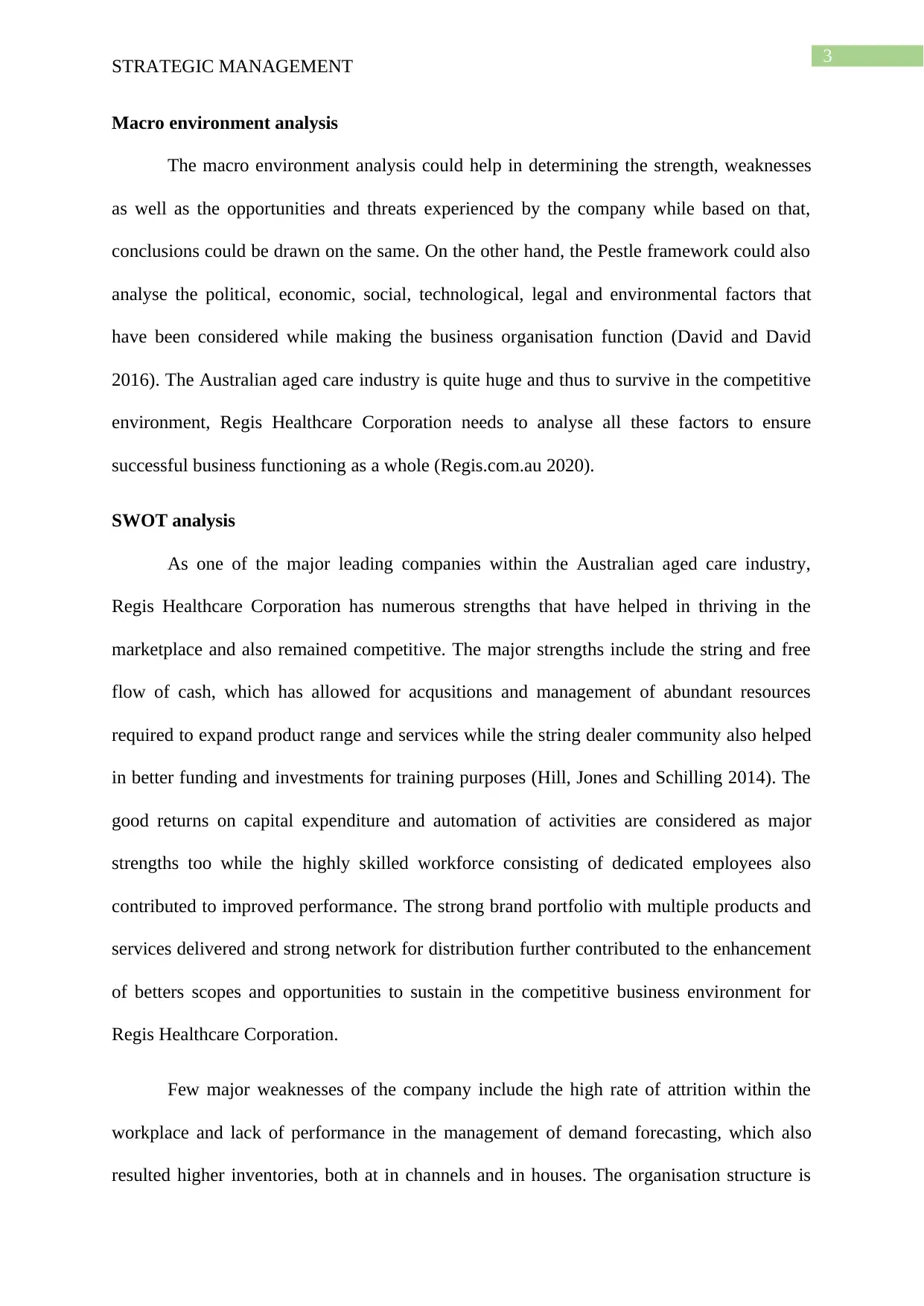
3
STRATEGIC MANAGEMENT
Macro environment analysis
The macro environment analysis could help in determining the strength, weaknesses
as well as the opportunities and threats experienced by the company while based on that,
conclusions could be drawn on the same. On the other hand, the Pestle framework could also
analyse the political, economic, social, technological, legal and environmental factors that
have been considered while making the business organisation function (David and David
2016). The Australian aged care industry is quite huge and thus to survive in the competitive
environment, Regis Healthcare Corporation needs to analyse all these factors to ensure
successful business functioning as a whole (Regis.com.au 2020).
SWOT analysis
As one of the major leading companies within the Australian aged care industry,
Regis Healthcare Corporation has numerous strengths that have helped in thriving in the
marketplace and also remained competitive. The major strengths include the string and free
flow of cash, which has allowed for acqusitions and management of abundant resources
required to expand product range and services while the string dealer community also helped
in better funding and investments for training purposes (Hill, Jones and Schilling 2014). The
good returns on capital expenditure and automation of activities are considered as major
strengths too while the highly skilled workforce consisting of dedicated employees also
contributed to improved performance. The strong brand portfolio with multiple products and
services delivered and strong network for distribution further contributed to the enhancement
of betters scopes and opportunities to sustain in the competitive business environment for
Regis Healthcare Corporation.
Few major weaknesses of the company include the high rate of attrition within the
workplace and lack of performance in the management of demand forecasting, which also
resulted higher inventories, both at in channels and in houses. The organisation structure is
STRATEGIC MANAGEMENT
Macro environment analysis
The macro environment analysis could help in determining the strength, weaknesses
as well as the opportunities and threats experienced by the company while based on that,
conclusions could be drawn on the same. On the other hand, the Pestle framework could also
analyse the political, economic, social, technological, legal and environmental factors that
have been considered while making the business organisation function (David and David
2016). The Australian aged care industry is quite huge and thus to survive in the competitive
environment, Regis Healthcare Corporation needs to analyse all these factors to ensure
successful business functioning as a whole (Regis.com.au 2020).
SWOT analysis
As one of the major leading companies within the Australian aged care industry,
Regis Healthcare Corporation has numerous strengths that have helped in thriving in the
marketplace and also remained competitive. The major strengths include the string and free
flow of cash, which has allowed for acqusitions and management of abundant resources
required to expand product range and services while the string dealer community also helped
in better funding and investments for training purposes (Hill, Jones and Schilling 2014). The
good returns on capital expenditure and automation of activities are considered as major
strengths too while the highly skilled workforce consisting of dedicated employees also
contributed to improved performance. The strong brand portfolio with multiple products and
services delivered and strong network for distribution further contributed to the enhancement
of betters scopes and opportunities to sustain in the competitive business environment for
Regis Healthcare Corporation.
Few major weaknesses of the company include the high rate of attrition within the
workplace and lack of performance in the management of demand forecasting, which also
resulted higher inventories, both at in channels and in houses. The organisation structure is
Paraphrase This Document
Need a fresh take? Get an instant paraphrase of this document with our AI Paraphraser
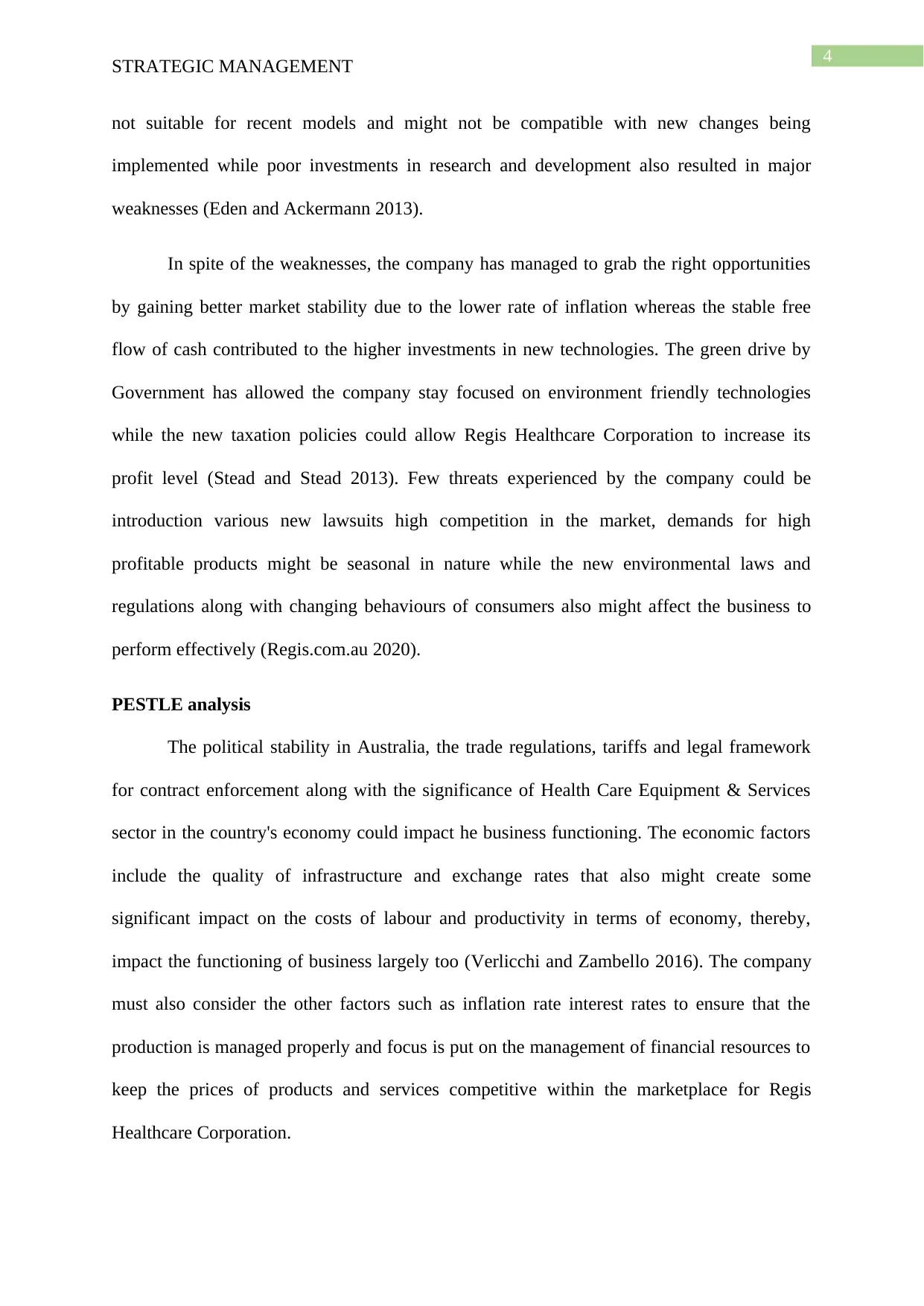
4
STRATEGIC MANAGEMENT
not suitable for recent models and might not be compatible with new changes being
implemented while poor investments in research and development also resulted in major
weaknesses (Eden and Ackermann 2013).
In spite of the weaknesses, the company has managed to grab the right opportunities
by gaining better market stability due to the lower rate of inflation whereas the stable free
flow of cash contributed to the higher investments in new technologies. The green drive by
Government has allowed the company stay focused on environment friendly technologies
while the new taxation policies could allow Regis Healthcare Corporation to increase its
profit level (Stead and Stead 2013). Few threats experienced by the company could be
introduction various new lawsuits high competition in the market, demands for high
profitable products might be seasonal in nature while the new environmental laws and
regulations along with changing behaviours of consumers also might affect the business to
perform effectively (Regis.com.au 2020).
PESTLE analysis
The political stability in Australia, the trade regulations, tariffs and legal framework
for contract enforcement along with the significance of Health Care Equipment & Services
sector in the country's economy could impact he business functioning. The economic factors
include the quality of infrastructure and exchange rates that also might create some
significant impact on the costs of labour and productivity in terms of economy, thereby,
impact the functioning of business largely too (Verlicchi and Zambello 2016). The company
must also consider the other factors such as inflation rate interest rates to ensure that the
production is managed properly and focus is put on the management of financial resources to
keep the prices of products and services competitive within the marketplace for Regis
Healthcare Corporation.
STRATEGIC MANAGEMENT
not suitable for recent models and might not be compatible with new changes being
implemented while poor investments in research and development also resulted in major
weaknesses (Eden and Ackermann 2013).
In spite of the weaknesses, the company has managed to grab the right opportunities
by gaining better market stability due to the lower rate of inflation whereas the stable free
flow of cash contributed to the higher investments in new technologies. The green drive by
Government has allowed the company stay focused on environment friendly technologies
while the new taxation policies could allow Regis Healthcare Corporation to increase its
profit level (Stead and Stead 2013). Few threats experienced by the company could be
introduction various new lawsuits high competition in the market, demands for high
profitable products might be seasonal in nature while the new environmental laws and
regulations along with changing behaviours of consumers also might affect the business to
perform effectively (Regis.com.au 2020).
PESTLE analysis
The political stability in Australia, the trade regulations, tariffs and legal framework
for contract enforcement along with the significance of Health Care Equipment & Services
sector in the country's economy could impact he business functioning. The economic factors
include the quality of infrastructure and exchange rates that also might create some
significant impact on the costs of labour and productivity in terms of economy, thereby,
impact the functioning of business largely too (Verlicchi and Zambello 2016). The company
must also consider the other factors such as inflation rate interest rates to ensure that the
production is managed properly and focus is put on the management of financial resources to
keep the prices of products and services competitive within the marketplace for Regis
Healthcare Corporation.
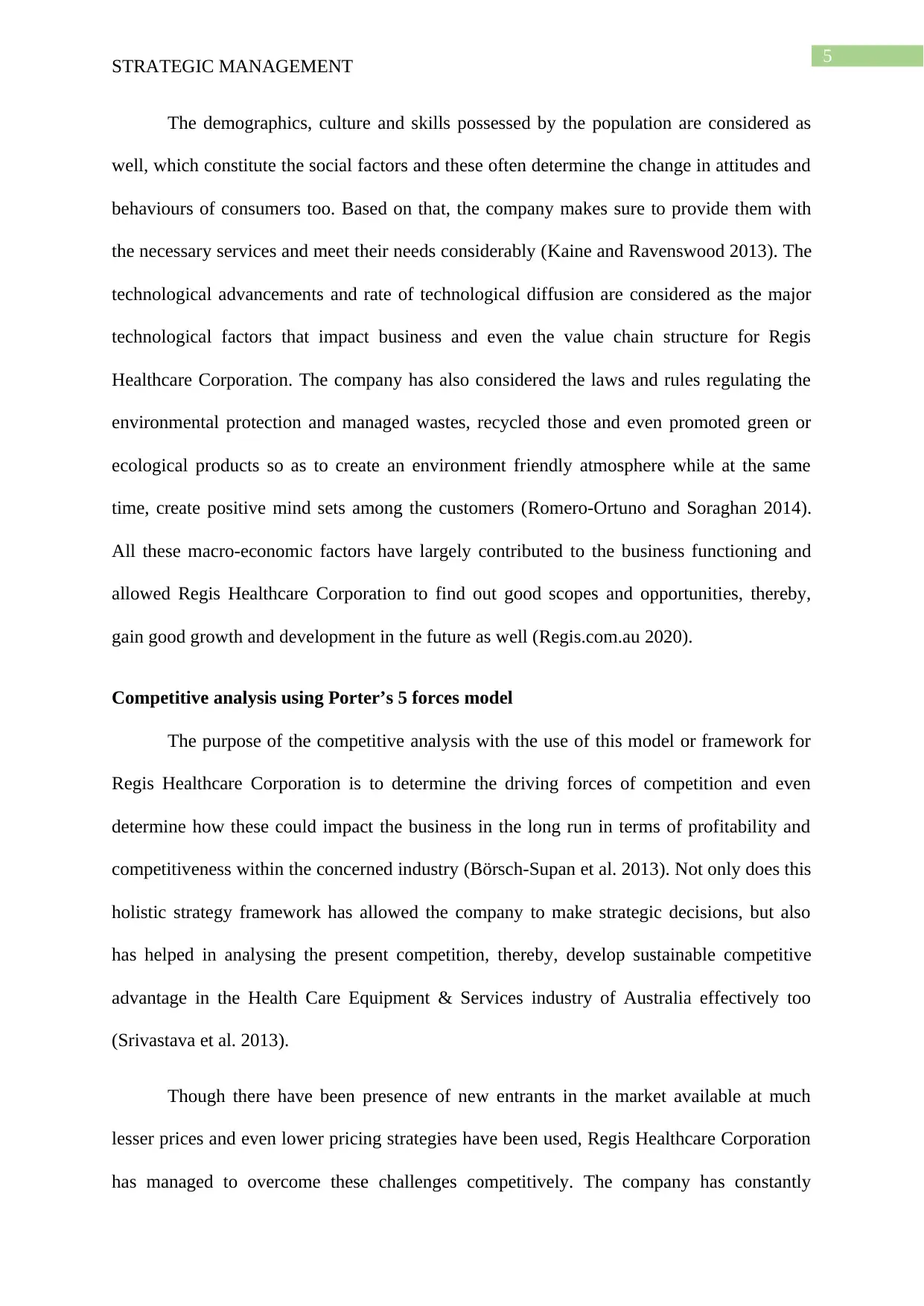
5
STRATEGIC MANAGEMENT
The demographics, culture and skills possessed by the population are considered as
well, which constitute the social factors and these often determine the change in attitudes and
behaviours of consumers too. Based on that, the company makes sure to provide them with
the necessary services and meet their needs considerably (Kaine and Ravenswood 2013). The
technological advancements and rate of technological diffusion are considered as the major
technological factors that impact business and even the value chain structure for Regis
Healthcare Corporation. The company has also considered the laws and rules regulating the
environmental protection and managed wastes, recycled those and even promoted green or
ecological products so as to create an environment friendly atmosphere while at the same
time, create positive mind sets among the customers (Romero-Ortuno and Soraghan 2014).
All these macro-economic factors have largely contributed to the business functioning and
allowed Regis Healthcare Corporation to find out good scopes and opportunities, thereby,
gain good growth and development in the future as well (Regis.com.au 2020).
Competitive analysis using Porter’s 5 forces model
The purpose of the competitive analysis with the use of this model or framework for
Regis Healthcare Corporation is to determine the driving forces of competition and even
determine how these could impact the business in the long run in terms of profitability and
competitiveness within the concerned industry (Börsch-Supan et al. 2013). Not only does this
holistic strategy framework has allowed the company to make strategic decisions, but also
has helped in analysing the present competition, thereby, develop sustainable competitive
advantage in the Health Care Equipment & Services industry of Australia effectively too
(Srivastava et al. 2013).
Though there have been presence of new entrants in the market available at much
lesser prices and even lower pricing strategies have been used, Regis Healthcare Corporation
has managed to overcome these challenges competitively. The company has constantly
STRATEGIC MANAGEMENT
The demographics, culture and skills possessed by the population are considered as
well, which constitute the social factors and these often determine the change in attitudes and
behaviours of consumers too. Based on that, the company makes sure to provide them with
the necessary services and meet their needs considerably (Kaine and Ravenswood 2013). The
technological advancements and rate of technological diffusion are considered as the major
technological factors that impact business and even the value chain structure for Regis
Healthcare Corporation. The company has also considered the laws and rules regulating the
environmental protection and managed wastes, recycled those and even promoted green or
ecological products so as to create an environment friendly atmosphere while at the same
time, create positive mind sets among the customers (Romero-Ortuno and Soraghan 2014).
All these macro-economic factors have largely contributed to the business functioning and
allowed Regis Healthcare Corporation to find out good scopes and opportunities, thereby,
gain good growth and development in the future as well (Regis.com.au 2020).
Competitive analysis using Porter’s 5 forces model
The purpose of the competitive analysis with the use of this model or framework for
Regis Healthcare Corporation is to determine the driving forces of competition and even
determine how these could impact the business in the long run in terms of profitability and
competitiveness within the concerned industry (Börsch-Supan et al. 2013). Not only does this
holistic strategy framework has allowed the company to make strategic decisions, but also
has helped in analysing the present competition, thereby, develop sustainable competitive
advantage in the Health Care Equipment & Services industry of Australia effectively too
(Srivastava et al. 2013).
Though there have been presence of new entrants in the market available at much
lesser prices and even lower pricing strategies have been used, Regis Healthcare Corporation
has managed to overcome these challenges competitively. The company has constantly
⊘ This is a preview!⊘
Do you want full access?
Subscribe today to unlock all pages.

Trusted by 1+ million students worldwide
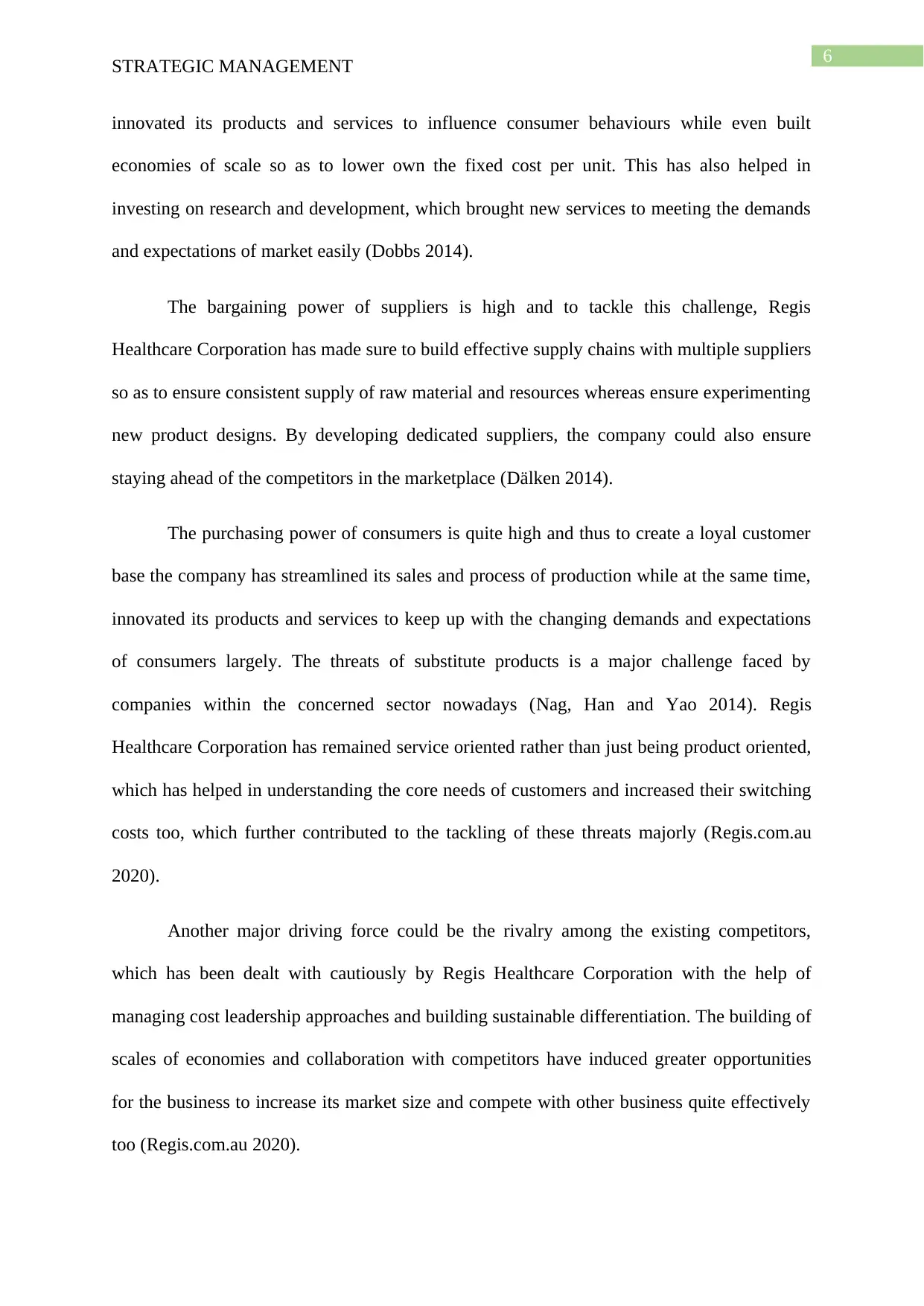
6
STRATEGIC MANAGEMENT
innovated its products and services to influence consumer behaviours while even built
economies of scale so as to lower own the fixed cost per unit. This has also helped in
investing on research and development, which brought new services to meeting the demands
and expectations of market easily (Dobbs 2014).
The bargaining power of suppliers is high and to tackle this challenge, Regis
Healthcare Corporation has made sure to build effective supply chains with multiple suppliers
so as to ensure consistent supply of raw material and resources whereas ensure experimenting
new product designs. By developing dedicated suppliers, the company could also ensure
staying ahead of the competitors in the marketplace (Dälken 2014).
The purchasing power of consumers is quite high and thus to create a loyal customer
base the company has streamlined its sales and process of production while at the same time,
innovated its products and services to keep up with the changing demands and expectations
of consumers largely. The threats of substitute products is a major challenge faced by
companies within the concerned sector nowadays (Nag, Han and Yao 2014). Regis
Healthcare Corporation has remained service oriented rather than just being product oriented,
which has helped in understanding the core needs of customers and increased their switching
costs too, which further contributed to the tackling of these threats majorly (Regis.com.au
2020).
Another major driving force could be the rivalry among the existing competitors,
which has been dealt with cautiously by Regis Healthcare Corporation with the help of
managing cost leadership approaches and building sustainable differentiation. The building of
scales of economies and collaboration with competitors have induced greater opportunities
for the business to increase its market size and compete with other business quite effectively
too (Regis.com.au 2020).
STRATEGIC MANAGEMENT
innovated its products and services to influence consumer behaviours while even built
economies of scale so as to lower own the fixed cost per unit. This has also helped in
investing on research and development, which brought new services to meeting the demands
and expectations of market easily (Dobbs 2014).
The bargaining power of suppliers is high and to tackle this challenge, Regis
Healthcare Corporation has made sure to build effective supply chains with multiple suppliers
so as to ensure consistent supply of raw material and resources whereas ensure experimenting
new product designs. By developing dedicated suppliers, the company could also ensure
staying ahead of the competitors in the marketplace (Dälken 2014).
The purchasing power of consumers is quite high and thus to create a loyal customer
base the company has streamlined its sales and process of production while at the same time,
innovated its products and services to keep up with the changing demands and expectations
of consumers largely. The threats of substitute products is a major challenge faced by
companies within the concerned sector nowadays (Nag, Han and Yao 2014). Regis
Healthcare Corporation has remained service oriented rather than just being product oriented,
which has helped in understanding the core needs of customers and increased their switching
costs too, which further contributed to the tackling of these threats majorly (Regis.com.au
2020).
Another major driving force could be the rivalry among the existing competitors,
which has been dealt with cautiously by Regis Healthcare Corporation with the help of
managing cost leadership approaches and building sustainable differentiation. The building of
scales of economies and collaboration with competitors have induced greater opportunities
for the business to increase its market size and compete with other business quite effectively
too (Regis.com.au 2020).
Paraphrase This Document
Need a fresh take? Get an instant paraphrase of this document with our AI Paraphraser
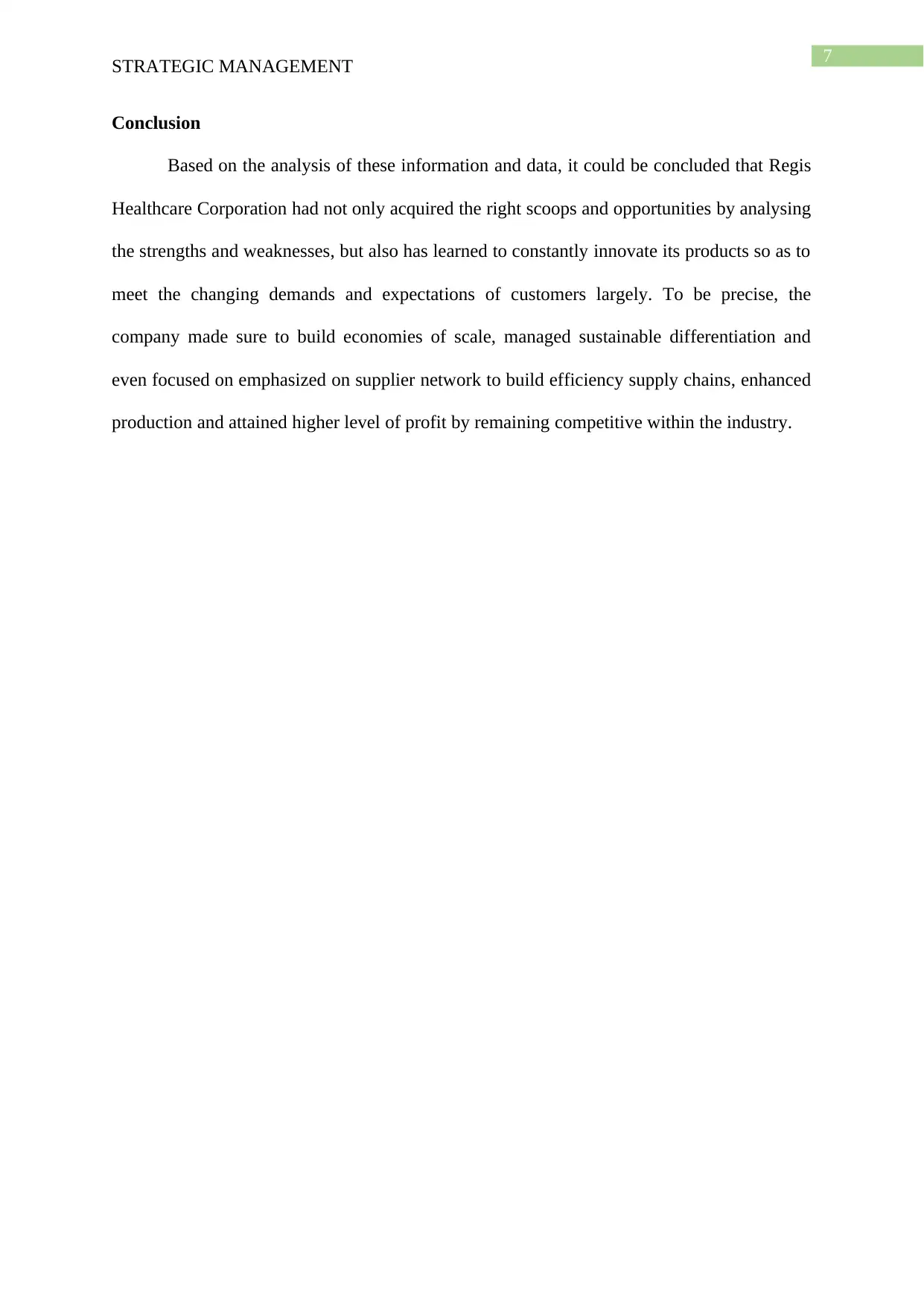
7
STRATEGIC MANAGEMENT
Conclusion
Based on the analysis of these information and data, it could be concluded that Regis
Healthcare Corporation had not only acquired the right scoops and opportunities by analysing
the strengths and weaknesses, but also has learned to constantly innovate its products so as to
meet the changing demands and expectations of customers largely. To be precise, the
company made sure to build economies of scale, managed sustainable differentiation and
even focused on emphasized on supplier network to build efficiency supply chains, enhanced
production and attained higher level of profit by remaining competitive within the industry.
STRATEGIC MANAGEMENT
Conclusion
Based on the analysis of these information and data, it could be concluded that Regis
Healthcare Corporation had not only acquired the right scoops and opportunities by analysing
the strengths and weaknesses, but also has learned to constantly innovate its products so as to
meet the changing demands and expectations of customers largely. To be precise, the
company made sure to build economies of scale, managed sustainable differentiation and
even focused on emphasized on supplier network to build efficiency supply chains, enhanced
production and attained higher level of profit by remaining competitive within the industry.
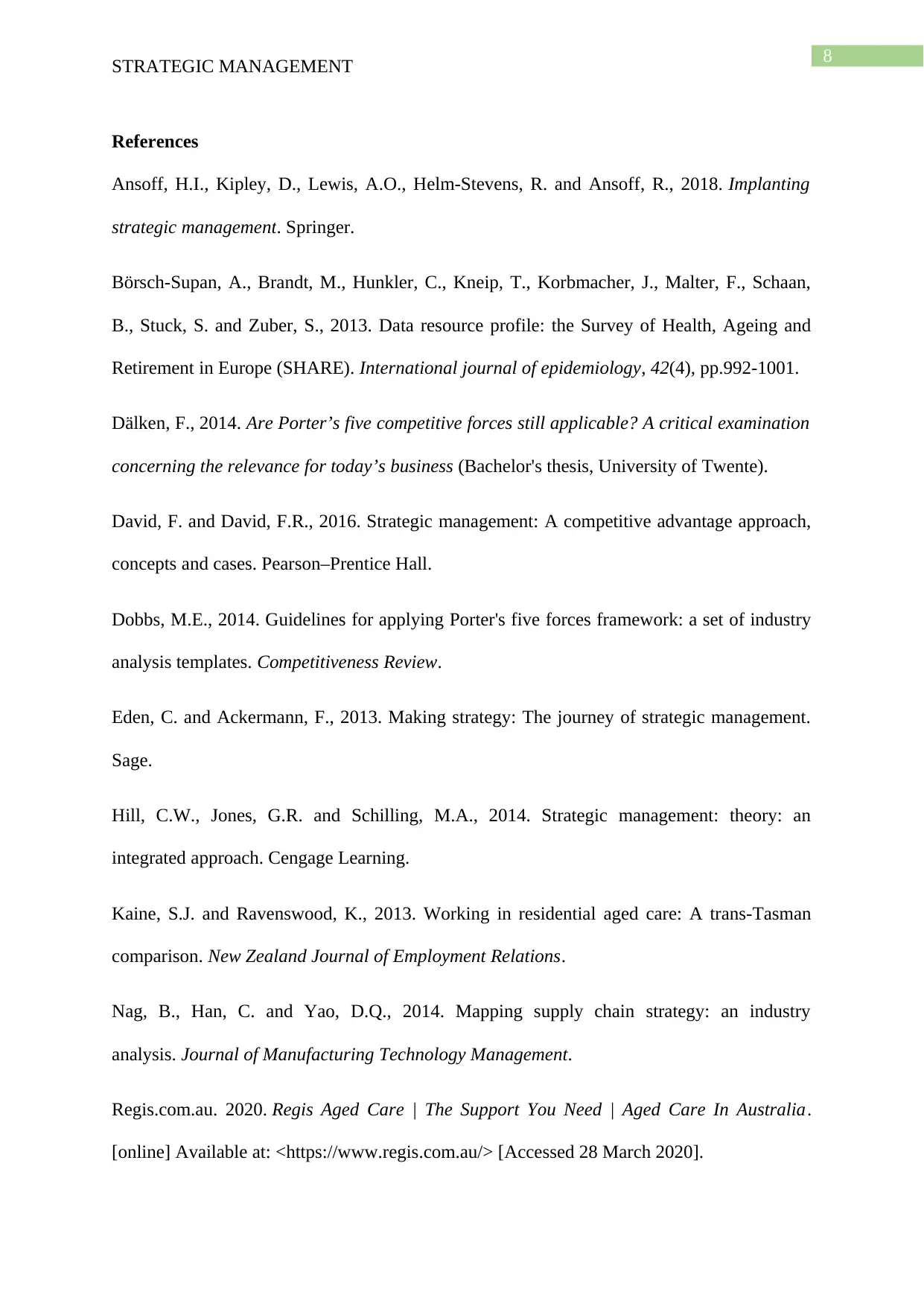
8
STRATEGIC MANAGEMENT
References
Ansoff, H.I., Kipley, D., Lewis, A.O., Helm-Stevens, R. and Ansoff, R., 2018. Implanting
strategic management. Springer.
Börsch-Supan, A., Brandt, M., Hunkler, C., Kneip, T., Korbmacher, J., Malter, F., Schaan,
B., Stuck, S. and Zuber, S., 2013. Data resource profile: the Survey of Health, Ageing and
Retirement in Europe (SHARE). International journal of epidemiology, 42(4), pp.992-1001.
Dälken, F., 2014. Are Porter’s five competitive forces still applicable? A critical examination
concerning the relevance for today’s business (Bachelor's thesis, University of Twente).
David, F. and David, F.R., 2016. Strategic management: A competitive advantage approach,
concepts and cases. Pearson–Prentice Hall.
Dobbs, M.E., 2014. Guidelines for applying Porter's five forces framework: a set of industry
analysis templates. Competitiveness Review.
Eden, C. and Ackermann, F., 2013. Making strategy: The journey of strategic management.
Sage.
Hill, C.W., Jones, G.R. and Schilling, M.A., 2014. Strategic management: theory: an
integrated approach. Cengage Learning.
Kaine, S.J. and Ravenswood, K., 2013. Working in residential aged care: A trans-Tasman
comparison. New Zealand Journal of Employment Relations.
Nag, B., Han, C. and Yao, D.Q., 2014. Mapping supply chain strategy: an industry
analysis. Journal of Manufacturing Technology Management.
Regis.com.au. 2020. Regis Aged Care | The Support You Need | Aged Care In Australia.
[online] Available at: <https://www.regis.com.au/> [Accessed 28 March 2020].
STRATEGIC MANAGEMENT
References
Ansoff, H.I., Kipley, D., Lewis, A.O., Helm-Stevens, R. and Ansoff, R., 2018. Implanting
strategic management. Springer.
Börsch-Supan, A., Brandt, M., Hunkler, C., Kneip, T., Korbmacher, J., Malter, F., Schaan,
B., Stuck, S. and Zuber, S., 2013. Data resource profile: the Survey of Health, Ageing and
Retirement in Europe (SHARE). International journal of epidemiology, 42(4), pp.992-1001.
Dälken, F., 2014. Are Porter’s five competitive forces still applicable? A critical examination
concerning the relevance for today’s business (Bachelor's thesis, University of Twente).
David, F. and David, F.R., 2016. Strategic management: A competitive advantage approach,
concepts and cases. Pearson–Prentice Hall.
Dobbs, M.E., 2014. Guidelines for applying Porter's five forces framework: a set of industry
analysis templates. Competitiveness Review.
Eden, C. and Ackermann, F., 2013. Making strategy: The journey of strategic management.
Sage.
Hill, C.W., Jones, G.R. and Schilling, M.A., 2014. Strategic management: theory: an
integrated approach. Cengage Learning.
Kaine, S.J. and Ravenswood, K., 2013. Working in residential aged care: A trans-Tasman
comparison. New Zealand Journal of Employment Relations.
Nag, B., Han, C. and Yao, D.Q., 2014. Mapping supply chain strategy: an industry
analysis. Journal of Manufacturing Technology Management.
Regis.com.au. 2020. Regis Aged Care | The Support You Need | Aged Care In Australia.
[online] Available at: <https://www.regis.com.au/> [Accessed 28 March 2020].
⊘ This is a preview!⊘
Do you want full access?
Subscribe today to unlock all pages.

Trusted by 1+ million students worldwide
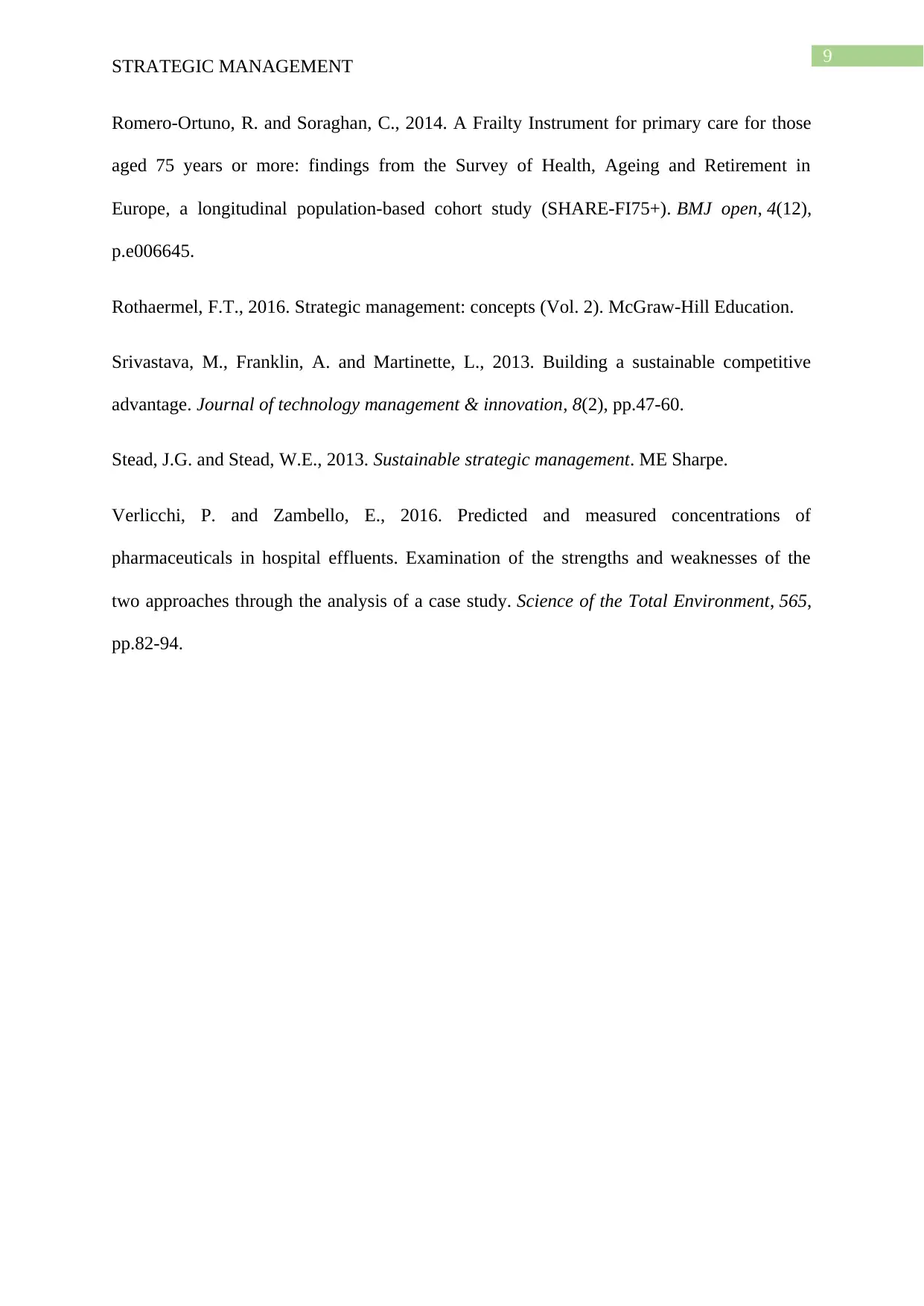
9
STRATEGIC MANAGEMENT
Romero-Ortuno, R. and Soraghan, C., 2014. A Frailty Instrument for primary care for those
aged 75 years or more: findings from the Survey of Health, Ageing and Retirement in
Europe, a longitudinal population-based cohort study (SHARE-FI75+). BMJ open, 4(12),
p.e006645.
Rothaermel, F.T., 2016. Strategic management: concepts (Vol. 2). McGraw-Hill Education.
Srivastava, M., Franklin, A. and Martinette, L., 2013. Building a sustainable competitive
advantage. Journal of technology management & innovation, 8(2), pp.47-60.
Stead, J.G. and Stead, W.E., 2013. Sustainable strategic management. ME Sharpe.
Verlicchi, P. and Zambello, E., 2016. Predicted and measured concentrations of
pharmaceuticals in hospital effluents. Examination of the strengths and weaknesses of the
two approaches through the analysis of a case study. Science of the Total Environment, 565,
pp.82-94.
STRATEGIC MANAGEMENT
Romero-Ortuno, R. and Soraghan, C., 2014. A Frailty Instrument for primary care for those
aged 75 years or more: findings from the Survey of Health, Ageing and Retirement in
Europe, a longitudinal population-based cohort study (SHARE-FI75+). BMJ open, 4(12),
p.e006645.
Rothaermel, F.T., 2016. Strategic management: concepts (Vol. 2). McGraw-Hill Education.
Srivastava, M., Franklin, A. and Martinette, L., 2013. Building a sustainable competitive
advantage. Journal of technology management & innovation, 8(2), pp.47-60.
Stead, J.G. and Stead, W.E., 2013. Sustainable strategic management. ME Sharpe.
Verlicchi, P. and Zambello, E., 2016. Predicted and measured concentrations of
pharmaceuticals in hospital effluents. Examination of the strengths and weaknesses of the
two approaches through the analysis of a case study. Science of the Total Environment, 565,
pp.82-94.
1 out of 10
Related Documents
Your All-in-One AI-Powered Toolkit for Academic Success.
+13062052269
info@desklib.com
Available 24*7 on WhatsApp / Email
![[object Object]](/_next/static/media/star-bottom.7253800d.svg)
Unlock your academic potential
Copyright © 2020–2025 A2Z Services. All Rights Reserved. Developed and managed by ZUCOL.





